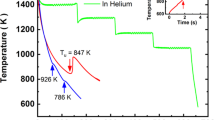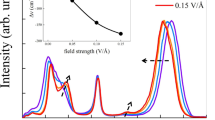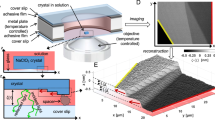Abstract
THE influence of electric fields on growth processes in insulating and poorly conducting solids has been examined in experiments ranging from those involving biological materials, such as performed by Becker and collaborators on bone growth in experimental animals1, to Gorskii's work on nucleation in super-cooled organic liquids2. A good deal of work has focused on orientation effects occurring on a substrate to which d.c. fields have been applied. For example, Chopra3 has shown effects on orientation of metal films during vacuum deposition, and Sinclair and Calbick4 have observed strong variations in orientation of a sodium chloride film deposited on fused silica with an applied d.c. field. We have examined growth rates of insulating crystals in the melt, solution and vapour phases and have experimental evidence that the rate of growth of an organic solid from the vapour phase can be controlled by applying a d.c. electric field to the growing surface. At low growth rates (0.2 µg/min), by applying an electric field of the order of 4,000 V/cm, it is in fact possible to prevent crystal growth.
This is a preview of subscription content, access via your institution
Access options
Subscribe to this journal
Receive 51 print issues and online access
$199.00 per year
only $3.90 per issue
Buy this article
- Purchase on Springer Link
- Instant access to full article PDF
Prices may be subject to local taxes which are calculated during checkout
Similar content being viewed by others
References
Becker, R. O., Bassett, C. A. L., and Bachman, C. H., Intern. Symp. Biodynamics of Bone, Henry Ford Hospital, Detroit, March 1963 (Little, Brown and Co., 1964). Bassett, C. A. L., and Becker, R. O., Science, 137, 1063 (1962). Becker, R. O., Nature, 199, 1304 (1963). Bassett, C. A. L., Pawluk, R. J., and Becker, R. O., Nature, 204, 652 (1964). Becker, R. O., and Brown, F. M., Nature, 206, 1325 (1965).
Gorskii, F. K., J. Exp. Theor. Phys. (USSR), 4, 522 (1934). Gorskii, F. K., Collected Scientific Papers, Minsk State Pedagogical Institute, 15, 308 (1955). Gorskii, F. K., and Prischcepa, L. T., Kristallizatsiya i Fazovye Peredhody, Otd. Fiz. Tverd. Tela i Poluprov., 386 (Acad. Sci. Byeloruss. SSB, 1962).
Chopra, K. L., Appl. Phys. Lett., 7, 140 (1965), and J. Appl. Phys., 37, 2249 (1966).
Sinclair, W. R., and Calbick, C. J., Appl. Phys. Lett., 10, 214 (1967).
Williams, R., Phys. Rev., 117, 487 (1960).
Author information
Authors and Affiliations
Rights and permissions
About this article
Cite this article
SZYMANSKI, A., LABES, M. Influence of Electric Fields on the Rate of Growth of Molecular Solids. Nature 220, 159–161 (1968). https://doi.org/10.1038/220159a0
Received:
Revised:
Issue Date:
DOI: https://doi.org/10.1038/220159a0
Comments
By submitting a comment you agree to abide by our Terms and Community Guidelines. If you find something abusive or that does not comply with our terms or guidelines please flag it as inappropriate.



